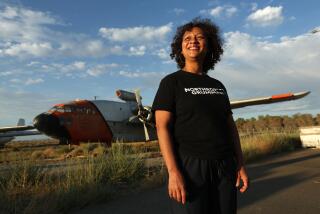Real Lessons at Virtual Schools : Online colleges can have you earning a degree from home. The programs are especially attractive to busy professionals.
- Share via
The last thing that John Breiding wanted to do after finishing his daytime teaching job in Carson was get in the car and fight the evening traffic all the way to UC Irvine, Pepperdine or USC.
The Seal Beach resident thought there had to be an easier way for a working man with a family to earn an MBA.
Then one day while cruising CompuServe, he heard about the online MBA program offered by the University of Phoenix. In September 1994, he enrolled and began attending his first class--by computer, of course.
“I think this is the way learning should be; this is education for the ‘90s,” says Breiding, who wants to go for his doctorate online as soon as he finishes his MBA this fall.
Thanks to technology, busy professionals like the 40-year-old Breiding are signing up for online degrees in such droves that schools cannot keep up with the demand.
At the University of Phoenix, whose online program is run out of San Francisco, enrollment has doubled to 1,600 students in the last year, says Tom Bishop, director of marketing for the university’s computer degree program.
“It’s exploding. It’s phenomenal what’s going on in this parallel universe,” says Bishop, whose school offers several graduate and undergraduate programs via computer and is adding three more. Tuition is $335 per unit for undergraduates and $415 per unit for graduate classes, commensurate with the school’s standard tuition fees.
More than classes are taking place online. Many universities offer virtual student unions, which are chat rooms where students can kick back for discussions.
Breiding belongs to an online “fratority,” which he describes as a social group that blends the elements of a fraternity and a sorority.
There are also online alumni groups that conduct regular meetings, online university art collections and libraries, and guest speakers who appear at real campus events, then log on to answer questions from the virtual community.
For instance, Olviero Toscani, the Italian adman who designs the controversial Benetton ads, recently spoke at the New School for Social Research in New York, then went online to answer questions from some of the 250 students enrolled in the university’s online bachelor’s degree program in liberal arts.
Indeed, you can find almost everything but a virtual parking lot and a virtual traffic jam. Small wonder that students--especially older students with full-time jobs--find online universities so appealing.
Breiding has logged on to classes from his family’s cabin in the Maine woods. He has done statistics homework while skiing in Utah. And most mornings at 5 a.m., when the world is still asleep, Breiding brews a pot of coffee and fires up his laptop for several uninterrupted hours before leaving for his job at the Los Angeles Unified School District’s Carnegie Middle School.
Breiding reckons he puts in 20 hours per week studying online.
“I spend more time on classwork and less time waiting in traffic, parking my car, walking to classes and waiting for other people to show up. It’s more efficient,” he says.
Because physical location is irrelevant for those studying by computer, folks in L.A. can attend university online in the Deep South, Switzerland or on the East Coast. Likewise, professors in Japan and Israel can lecture to students in Los Angeles.
Consider the online bachelor’s degree program in liberal arts at the New School for Social Research, which began with three pilot classes in 1994 and now offers nearly 100 classes throughout the year and has 350 students.
Before beginning their online classes, teachers must go through a three-month training course on the computer, according to Meg Foley McCabe, the school’s online program coordinator. To ensure more personalized attention, classes are limited to 12 to 15 students.
At the semester’s start, professors introduce themselves and post their syllabi, reading lists and class requirements just as they would in a real classroom. Professors also have weekly phone hours to make themselves available to individual students.
During the semester, they post weekly lectures and assign homework, including discussion questions. Students log on a minimum of three times per week to post their responses.
“Usually people participate five times a week, so it moves at a very intensive pace,” McCabe says.
To log on, students connect directly through the Internet, where they can download snippets of video, photos and graphics. Term papers can be faxed or filed over the computer, and professors can even mark up term papers on the screen.
“We’re more than just classes; we are going to become an entire university on the Internet, not just a place to trade messages,” says Stephen Anspacher, director of distance learning at New School for Social Research.
No one seems to know exactly how many schools offer online degrees, but their numbers grow each month and include the New Jersey Institute of Technology, the University of Wisconsin and Boise State University. Many other universities offer classes online. And governors of 11 Western states met recently to explore the creation of a “virtual university” that would operate exclusively online.
Many corporate employers reimburse the tuition for online classes just as they do other courses. That is the policy at PacifiCare Health Systems in Cypress, says Nicole Rice, a training manager in career planning.
“We looked into it quite extensively to make sure they were getting class participation, and we found it actually enables them to get wider exposure to students from different geographical groups,” Rice says.
Some academics worry that education will be cheapened online and standards devaluated. Which raises the question: How good are these programs? Few have been systematically evaluated, according to an official at the Fund for the Improvement of Post-Secondary Education at the Department of Education.
But the evaluations that have been done are encouraging. In New Jersey, for instance, evaluators compared grades between a group of online and regular students. The only significant difference was that online students scored higher in computer science courses.
Students as well as teachers say computer education requires more participation than sitting and snoozing in the back of a classroom.
“An online instructor gets to know students a lot better than a classroom instructor, because online you have to talk,” says professor Steve Williams, who teaches leadership and organizational behavior online for the University of Phoenix. “Think back to your classroom and how many kids never said a word. That doesn’t happen online.”
More to Read
Sign up for Essential California
The most important California stories and recommendations in your inbox every morning.
You may occasionally receive promotional content from the Los Angeles Times.













